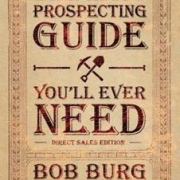Blog Marketing and Network Marketing – Sisters Under the Skin
Network marketers who ask themselves the question “Who do I talk to next now that my original list of names has run out?” might find answers in Bob Burg’s The Last Prospecting Guide You’ll Ever Need: Direct Sales Edition. While Berg discusses salespeople’s face-to-face and telephone encounters with their prospects, blog content writers can take some tips from him as well.
- Mega-successful networkers are active givers, “constantly on the lookout for a piece of information that will interest someone in their network. They recommend great books, make lots of introductions.
I’ve spent more than a decade now putting together a collection of books that serve as blog writing resources – books about writing, “tidbit treasure” books, books about marketing, books about sales, and books about corporate blogging. Many Say It for You blog posts are built around content from specific books, with links to help readers order the book for themselves. I often recommend books to my Twitter followers as well.
- Successful networkers are “connectors”, realizing that everyone they meet might turn out to be a valuable contact to someone else in their network.
When I’m creating content for a business, I need to keep up on what others are saying on the topic, on what’s in the news, and about what problems and questions have been surfacing that relate to what my client sells and what that business or practice does for its clients. By staying alert, I often find problems best solved by networking colleagues rather than by myself or my blogging client.
- Successful networkers enjoy the challenge, the learning, and the people with whom they interact.
In the business world in general, I find, we get tied up in making our products or in providing service to our customers and clients, and sometimes forget how much help the right words can be. The challenge is that often business owners and professional practitioners remain “unblogged”, mostly for lack of time. The ultimate challenge for content writers is to make that connection between them and all the searchers who need their experience and knowhow.
- Successful networkers are always on the lookout for things that can help others improve their business.
At Say It For You, we advise content writers to find complementary businesses or practices. Ask those owners (or cite their blogs) for tips they can offer your readers. Pet care professionals can share tips from carpet cleaning pros – or the reverse! If you’re a carpet cleaning pro, you can share tips from allergists as well. If you’re an insurance advisor, offer tips from car dealers about accident prevention…
Blog marketing and networking – sisters under the skin!






Follow us online!